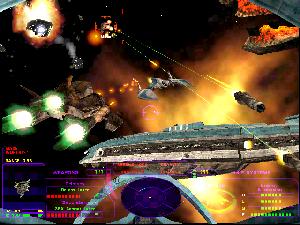No fringe benefits.
I’ll just come right out and say it: Bruce Campbell is The Man. Not only has
he defeated countless hordes of pearly-eyed, slogan-quipping deadites in the
classic Evil Dead movies, but he has also single-handedly managed
to do something usually impossible – make a mediocre game fun, even inciting.
The game is Tachyon: The Fringe. Tachyon is a space combat,
freewheeling, Han Solo sort of experience in which you take on the role of Jake
Logan (voice of Bruce Campbell), a respected contract pilot in Sol sector. Without
much warning, Logan finds himself framed for the horrific destruction of a hospital
facility and is exiled from the relative civilization of Sol out into the wilds
of The Fringe, a newly colonized region of space run by madmen. It is in this
region of guile, treachery and conflict that Logan must rebuild his life, make
a new fortune, and discover the secrets behind the atrocity that landed him
there.
The principal authorities in the region are GalSpan, an unscrupulous mining
conglomerate, the Bora, a group of colonists fighting dispossession at the hands
of GalSpan, and the Star Patrol, a ubiquitous police force. After getting your
feet wet in The Fringe, you have to decide how to cast your lot – Bora or GalSpan.
Gameplay is sort of a cross between Privateer and StarLancer.
While you have freedom to take side missions not provided by GalSpan or Bora,
the major missions play out in a linear fashion and you only have as much freedom
as is convenient for the plot. The Fringe has several large regions, each of
which has various locales. You initially have very little access, though by
the end you can cruise all over the place.
Time goes by at your own pace. Missions hang around until you do them, no
matter how time-sensitive their briefings might make them seem. To compound
matters, some Bora and Galspan missions are non-essential, so you might find
yourself at the end of the campaign but still able to play one or two of the
first few missions. It’s a pity, because this eliminates much of the feeling
of progress you normally expect from a space combat game.
Speaking of which, the way that Tachyon handles upgrades is severely
flawed. Instead of showing you almost everything available so that you have
a goal to work towards, Tachyon only makes advanced hardware available
after the completion of certain missions. You don’t know what you’ll unlock
with each mission unless you have a strategy guide. While this provides incentive
to play the independent missions, it eliminates much of the freedom. You can’t
even see all the ships until the last couple missions. This basically curtails
the privateering, freewheeling feeling that is the basis for most non-military
space combat games. There is no elite-style trading either – you’re just a mercenary.
You’re also a very curt mercenary. Often, just when things are heating up in a mission (like when you take out a few fighters but two capitol ships hyper-space in), your contract is completed and you don’t have to stick around for the drama, nor are you rewarded if you do. But that really doesn’t matter much, because fighting and flying in Tachyon isn’t much fun.
The ships you fly handle decently, but not very smoothly. It doesn’t feel
natural, especially after the realism of StarLancer. On the bright side,
there are a few cool advanced features, such as reverse thrust and a slide option
that keeps your direction vector constant while you can pivot (an old feature
from Wing Commander 3 and 4).
Still, enemy AI is plain. Enemies don’t maneuver enough. Weapon energy and
afterburners are on short supply and take very long to recharge, which results
in slow space-flight and fairly lethargic combat. 
The ships are modeled well, with the GalSpan being sleek and technological
and the Bora looking slapped together from old rusty parts. Space stations are
massive, spanning miles of complex pipe-work. Just on size alone, they are very
impressive.
The texturing, however, is crippled by the old Glide (native 3DFX 3D acceleration
API) limit of 256×256 texture resolution that makes everything lack sharp definition.
D3D or OpenGl would have worked better, or even a detail texture system like
Unreal and Unreal Tournament.
Also, there are a lot of 2D sprite based effects that were rendered at low resolution
only and look blocky and cartoonish at higher resolutions. Landing lights, shield
effects, and even the nebula representation lack detail or realism. Weapons
are fairly plain, except for the railgun, which looks great. Explosions are
decent, although abrupt and lacking variety.
Overall, Tachyon looks good enough to just barely get by, but its dated
appearance is a dead giveaway to the engine’s origins in NovaLogic’s flight
simulations like F22-Lighning 3, F-16
Multi-Role Fighter, and MiG-29 Fulcrum.
This is also a buggy game. NovaLogic has already released two patches, but there is a very annoying and unpredictable crash bug which freezes up your computer and necessitates a hardware restart.
Sounds are also fairly bad. Weapon effects, ships sounds, and the rest all are grainy and unconvincing.
In an odd twist, voice acting is what saves the game. Bruce Campbell does such a good job of creating the Jake Logan character and making you care about him that despite the failings and halfway successes of the game, you are drawn into the stories and compelled to see how things turn out. Bruce Campbell takes a fair game and makes it fun.
Despite Tachyon‘s various problems, it is a fun ride. It even includes
an innovative team-based multi-player option called Base Wars, which is something
like a real-time strategy game with everyone playing a role. But if you want
good space combat, look elsewhere to StarLancer, FreeSpace
2, or X-Wing
Alliance.

-
Bruce Campbell!
-
Cool "Base Wars" Concept
-
Mediocre Graphics
-
Mediocre Space Combat
-
Half-Assed Privateering
-
Lets You Leave Missions Too Soon











